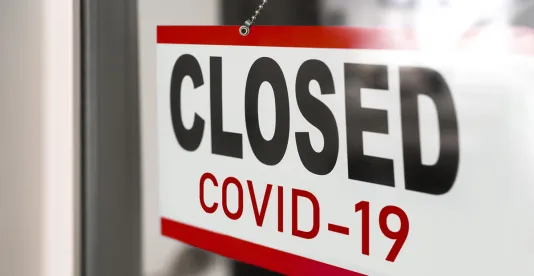On December 17, 2021, the Sixth Circuit Court of Appeals, in a 2-1 decision, dissolved the stay previously placed on OSHA’s Emergency Temporary Standard (“ETS”) by the Fifth Circuit. The ETS mandates employers with 100 or more employees require all employees be fully vaccinated against COVID-19 or be required to wear face coverings and undergo weekly testing. Our summary of the ETS’s requirements are available here.
The Sixth Circuit did not address how its decision would impact the timing of the ETS’s vaccination and testing and requirements, which were originally set to go into effect December 6, 2021, and January 4, 2022, respectively. The day after the Sixth Circuit’s decision, OSHA announced that it will not issue citations for noncompliance with the ETS requirements before January 10, 2022, with the exception of the standard’s testing requirements, which will not be enforced until February 9, 2022, so long as the employer is exercising reasonable, good faith efforts to come into compliance with the standard. Therefore, while the ETS is now in effect, OSHA will not enforce its requirements until the dates noted above.
Several petitioners immediately filed an emergency application with the U.S. Supreme Court to stay the Sixth Circuit’s order dissolving the stay, seeking to reinstate the stay until the case can be heard by the highest court. As such, it’s possible the landscape surrounding the ETS could change yet again.
More Details
As we previously reported here, OSHA published the ETS on November 5, 2021. The very next day, on November 6, 2021, the Fifth Circuit Court of Appeals stayed the ETS pending judicial review. The Fifth Circuit renewed that decision in an opinion issued on November 12, raising several reasons why the ETS was likely to be struck down.
Because multiple petitions challenging the ETS had been filed in several circuits, the judicial panel on multidistrict litigation conducted a lottery to select one court of appeals to hear the petitions. On November 16, 2021, the Sixth Circuit was chosen in that lottery and all petitions were ultimately consolidated there. Shortly thereafter, OSHA filed an emergency motion to dissolve the Fifth Circuit’s stay of the ETS.
On December 17, 2021, a three-judge panel of the Sixth Circuit issued an order dissolving the Fifth Circuit’s stay. The majority opinion addressed several arguments that had been raised against the ETS both by petitioners and by the Fifth Circuit when renewing the stay, including:
-
Finding that OSHA had the statutory authority to implement a national vaccine-or-test mandate and that as an agent that causes bodily harm, a virus falls squarely within the scope of OSHA’s emergency standard statutory authority. The Court pointed to OSHA’s longstanding authority to protect workers against infectious diseases, both through the OSH Act and other statutes.
-
Rejecting the Fifth Circuit’s argument that the ETS violated the “major questions doctrine” because the ETS had too much “vast economic and political significance” to be implemented without a clear grant of authority from Congress. The Court found that the major questions doctrine was inapplicable both because OSHA had been granted the appropriate authority and because the ETS was not an enormous expansion of OSHA’s prior regulatory powers as OSHA has been regulating workplace health and safety for decades.
-
Finding that the ETS was based on substantial evidence and that OSHA enacted the ETS in a reasonable manner. Addressing the Fifth Circuit’s view that OSHA’s failure to implement the ETS at the outset of the pandemic implied that the ETS does not address a true emergency, the Court found that whether a true emergency exists does not turn on when OSHA implements the ETS. The Court cited OSHA’s reliance on the rise of the Delta variant and the FDA approval of several vaccines as evidence that OSHA was responding to a true emergency.
-
Rejecting the argument that OSHA needed to show potential COVID-19 exposure in all workplaces in order to prove COVID-19 is a “grave danger” as contemplated by the OSH Act. Instead the Court stated that OSHA’s public health data detailing the vast deleterious effect COVID-19 had on workers and the public at large proved COVID-19 was a “grave danger” to all workplaces.
-
Finding the ETS does not violate the Commerce Clause of the Constitution and rejecting the argument that infectious disease can only be addressed through the exercise of state police powers.
-
Concluding that petitioners could not show irreparable harm because the ETS provides employers with multiple options aside from vaccination itself (e.g. mask-and-test, seeking a variance from the standard, etc.). The Court found that delaying the implementation of the ETS puts workers and the general public at further risk by failing to curtail the spread of the COVID-19 virus.
In a dissent, Judge Joan Larsen argued that OSHA does not have the statutory authority to implement the ETS because the ETS was not narrowly tailored to only include requirements “necessary” to protect employees from “grave danger.” Specifically, Judge Larsen argued the ETS was overbroad as there were other reasonable alternatives, such as requiring vaccination only for the most vulnerable workers, and because the ETS applied to young workers who do not typically experience significant symptoms from COVID-19. Judge Larsen also argued that the ETS violates the major questions doctrine because OSHA has never issued an ETS mandating vaccination on such a broad scale and that petitioners will be irreparably harmed by the ETS because of the potential adverse employment action some employees will face and the potential worker shortage the vaccine mandate may cause.






 />i
/>i
